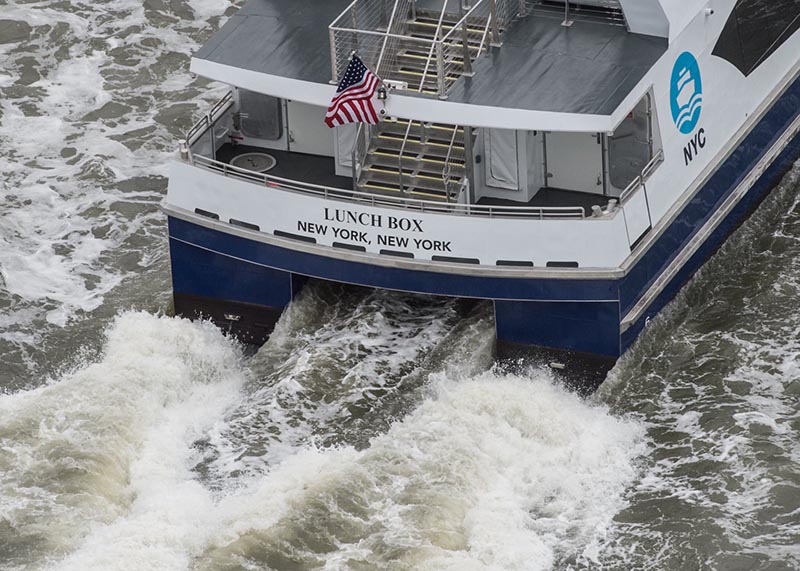Long lines and customer complaints will bring bigger boats to the new NYC Ferry public system, with a plan to increase capacity to 250 passengers on three vessels scheduled for 2018 delivery.
Already additional private ferries are being leased to add capacity on the East River between Manhattan, Brooklyn and Queens, where riders have complained of long delays and crowding.
Orders for the new fleet being built by Horizon Shipbuilding Inc., Bayou La Batre, Ala., and Metal Shark, Franklin, La., were earlier increased from 19 to 20 vessels with capacity for 149 passengers. Now the last three in that series will be increased in size and horsepower, according to the New York City Economic Development Corporation (NYCEDC).
The delivery schedule will remain the same through 2017 and early 2018, NYCEDC officials said. They could not immediately offer more details about the cost — or which shipyard would built the last three vessels. The construction program has been somewhat novel for the industry, with Horizon and Metal Shark closely cooperating with each other along with designers of Incat Crowther and operators NYC Ferry by Hornblower.
In the meantime, the NYCEDC is leasing additional boats from New York Waterway — one of Hornblower’s rivals in the initial 2015 bidding to operate the new citywide service. Two of the private fleet’s 400-passenger monohulls will provide additional weekend capacity on the East River, with two of its 150-passenger catamarans on those runs during the weekdays.
The public ferry with tickets at $2.75 — the same as a subway fare — is a signature project for Mayor Bill de Blasio, bringing a new commuter option to far-flung neighborhoods, and opening them to new residential development.
The May 1 startup was heavily promoted for months, but city officials say ridership has far exceeded expectations, starting with the Wall Street to Rockaway route. Within a week, the East River crossings were delayed by a Brooklyn power substation spill that led the Coast Guard to impose speed limits.
Lines and wait times grew over the Memorial Day weekend and with the opening of Governors Island. City officials hoped the June 1 start of additional service to Brooklyn would ease delays and crowding and Hornblower is continuing to adjust scheduling.
Data from ticket sales and the NYC Ferry's smartphone app for users plays a big role in fine-tuning the system, and operators maintain a social media operation on Twitter and Facebook to field users' complaints, interact and advise the public of problems.
Critics say the ridership demand should have been anticipated, given the experience of for-profit private operators on the East River, when pricing for short routes was around $4.
"They made a $2.75 fare. What did they think was going to happen?" said Tom Fox, a founder of New York Water Taxi and a prominent figure in the industry. The system's early problems range from "everything from the fare structure, to only one size boat fits all, to the rush to production," he said.
Fox left New York Water Taxi five years ago but has remained one of the more prominent skeptics of the de Blasio plan. Its biggest danger is that problems will turn off ferry patrons unless they are resolved soon, he says.
"I find this annoying because we worked 20 years to get ferries to be an accepted mode of transportation again. I want to see the waterfront succeed. It's critical to the city," Fox said. "But not if people think it's overcrowded, unreliable."
Those challenges have been aggravated by troubles with both the city subway and regional commuter rail system, pushing more commuters to seek alternatives. NY Waterway has added routes so New Jersey commuters can ditch their trains and get across the Hudson River.
Demand for ferry service will grow in July. The state Metropolitan Transportation Authority announced this week it too will seek to engage ferries to help ease rail commuting problems.





